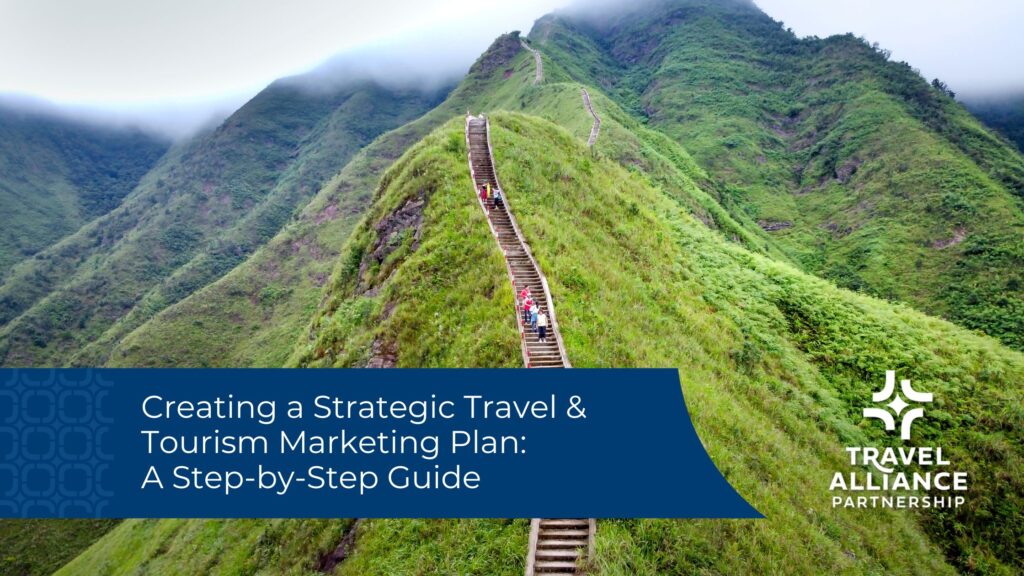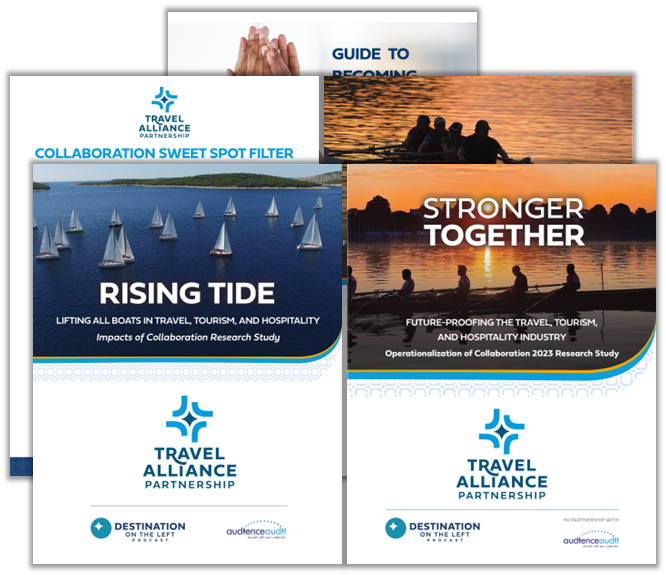Creating a Strategic Travel and Tourism Marketing Plan: A Step-by-Step Guide
Strategic marketing is about attracting the right people, at the right time, with the right message. A clear, strategic marketing plan is your blueprint for sustainable growth — to drive more visitation, elevate your brand, and drive broader economic impact.
This guide outlines the seven steps our team uses, showing you how to build a tourism marketing strategy that’s not only effective, but also realistic and actionable.

Step 1: Start with Research & Discovery
Gathering information sets the stage, helping you make informed, strategic decisions based on real data rather than gut feelings or outdated assumptions. This is your time to get curious, gather context, and identify the challenges and opportunities unique to your destination or organization.
Here’s what to dig into:
- Visitor data: Who’s coming now? Who used to come but hasn’t returned? What are your top markets by volume and spend? What are your most popular experiences or travel seasons?
- Competitor analysis: What destinations or brands are targeting the same audiences? What’s their positioning, messaging, and media mix? What’s working well for them and what’s missing?
- Stakeholder input: What are your tourism partners, board, or community members seeing and hearing? Their perspectives add richness to your understanding.
- Industry trends: From accessibility to workforce shifts, changing traveler behaviors to economic uncertainty — identify what’s influencing the broader landscape.
- SWOT analysis: Get honest about your strengths, weaknesses, opportunities, and threats. This helps focus your efforts and uncover strategic advantages.
There are lots of great resources out there start with some of our favorites in the travel, tourism and hospitality industry:
- ADARA
- Destination Analysts
- Family Travel Association
- Longwoods International
- MMGY Travel
- NYC & Company
- US Travel
TAP tip: Don’t get stuck in research mode. Set a deadline, summarize your insights, and move forward with clarity.
Step 2: Clarify Your Brand & Unique Positioning
We call this step the “situational analysis” because it takes into account not only your brand, but all the research you did. Remember that your brand isn’t just your logo. Your brand is the experience visitors have with you. In a crowded marketplace, clarity is a superpower. Start by answering these questions:
- What sets your destination or business apart?
- Why would visitors choose you over others?
- How do you want people to feel when they experience your brand?
If you’re a DMO, this is where your community’s story shines. If you’re a tour operator or product owner, this is where your voice and values set you apart.
Now it’s time to take a deeper look at everything together. Answer these questions:
- What do our consumers want? What are they looking for, based on what we know and what we’ve gathered? Are any trends influencing our main target audience?
- How would you describe your brand in one sentence?
- What is one way you can differentiate from the competition? Are you in a place to outshine in some aspect? Maybe you can ‘zig’ while others ‘zag.’ You might also take inspiration from the competition and aspire to a similar quality or level.
These are the basis for your positioning. Our process takes it one step further to create an overall, cohesive positioning statement that captures the essence of all three.
Step 3: Define Your Goals & Objectives
Goals are the guideposts for your plan — they help your team stay aligned and focused on outcomes that matter. Marketing’s role is to amplify your voice and attract visitors, serving your overall organization goals. If you have annual or overall goals set for your organization, look at where marketing can support those. That’s your starting point for marketing goals.
Whether you’re planning a statewide awareness campaign or looking to increase bookings for a seasonal tour, your goals should be SMART:
- Specific: Target a precise objective (e.g., Increase midweek hotel occupancy by 10%).
- Measurable: Use quantifiable metrics that you can actually track (e.g., Gain 500 new email subscribers).
- Attainable: Focus on what is practical and achievable. Be sure to consider the resources you have available. Ask yourself — do we have the capacity to achieve this with the resources we currently have or can get access to?
- Relevant: Your goal needs to relate to what’s happening in your organization and in the wider industry. Make sure it connects to your mission, reflects current trends, and acknowledges economic realities. If it doesn’t support your broader objectives, it’s likely a distraction.
- Time-bound: Set deadlines to track progress (e.g., Launch a fall campaign by Q2).
TAP Tip: Don’t set too many. Focus on 3-5 high-impact objectives that align with your capacity and budget.
With your goals defined, write down 3-5 high-level strategies that can support each goal. On a road trip, goals are our destination. Strategies are the roadmap, showing the route we’ll take to get there. Tactics are our vehicles and KPIs (Key Performance Indicators) are the road markers along the way.
Step 4: Define Your Target Audiences
Audience insights help you personalize your messaging, refine your targeting, and build experiences that resonate. Understanding your audience is about deeply knowing who you’re talking to and what motivates them. This step helps you turn curiosity into connection, envisioning broad groups as real people.
Build audience profiles based on:
- Demographics & psychographics: Age, geography, interests, values, and lifestyle.
- Travel behaviors: Solo vs. group travel, luxury vs. budget, cultural vs. leisure motivations.
- Booking patterns: How far in advance they book, what platforms they use, and what influences their decisions.
On episode 96 of Destination on the Left, our research partner Susan Baier of Audience Audit talked about getting beyond the who, what and where of your audience and getting into the why. The “why” is the most important piece of understanding your customer. It provides the insight needed to tailor communications to speak to them.
Craft Your Key Messages
Your key messages are the bridge between what you want to say and what your audience needs to hear. They guide your storytelling, shape your campaigns, and ensure consistency across every touchpoint — from social captions to sales pitches.
Start by developing 2–3 core messages per target audience. Each message should:
- Align with your brand and goals
- Reflect what’s most meaningful to that specific audience
- Be clear, concise, and compelling
- Inspire action or build trust
In the simplest way, put yourself in the customer’s shoes. Think through how they might perceive your message. You want to make sure there is something in it for them. What messages will pique their interest or motivate them to interact with your brand? Does the targeted audience care about what you have to say? Will they be better off for having the knowledge that you are sharing? How will this knowledge help meet your marketing objectives?
Step 5: Create Your Tactical Plan
Your tactical plan is where strategy becomes execution — it maps out what you’ll do, when you’ll do it, and how it will get done. We build tactical plans using the PESO Model created by Spin Sucks. Listen to episodes 437-440 of Destination on the Left for in-depth looks at how each type of media fits into the overall plan.
- Paid: Social ads, digital campaigns, print ads, sponsored content (episode 437 with Colleen Senglaub)
- Earned: PR, media coverage, influencer partnerships (episode 438 with Colleen Onuffer)
- Shared: Social media, user-generated content, partner networks (episode 439 with Brittany Lynn)
- Owned: Website, blog, email newsletter (episode 440 with Camille Zess)
TAP tip: You don’t have to do everything, but capture it all here. This makes the plan longer-lasting and able to be reused year after year. In the action plan, you can prioritize the tactics that set a solid foundation.
Step 6: Measurement & Optimization
Measurement is how you prove what’s working — and pivot when it’s not. Here is where you include how you will measure the effectiveness of the tactics you outlined. Start with the KPIs from your SMART goals, and add in the metrics needed for the Paid, Earned, Shared and Owned tactics from Step 5. These might include:
- Website traffic and page engagement
- Email open and click rates
- Social media growth and engagement
- Inquiries or conversions from specific campaigns
- Earned media placements
- Ad reach, impressions, clicks, click through rates
Build in regular review cycles (monthly, quarterly) and leave room to adapt. The best plans aren’t perfect — they’re responsive, nimble, and always evolving.
Step 7: Create an Action Plan & Assign Responsibilities
Plan out the full year, month by month, detailing which tactics will take place when. Some tactics might be ongoing and happen every month such as social media or email marketing. Other tactics might occur only during certain times of year based on the seasonality of your brand or timing of a trade show. The more detail you can put into your timeline the more likely you will be to stay on track with your plan.
Consider these elements:
- Who’s responsible for what?
- What’s the timeline for each piece?
- What are the key milestones?
- What tools or resources are needed?
Use project management tools or simple checklists to keep things moving. Accountability turns plans into progress. Remember this is a living and breathing document, it’s not written in stone and it can easily be changed and adapted as you move through the year. Just having the plan is a huge step in helping you to achieve your goals in the new year.
Need help tailoring your marketing strategy to your specific destination, team, or budget? TAP offers resources, templates, and support — all rooted in collaboration, community, and the belief that tourism holds the power to make or break the economic vitality of a region.
Related Posts
How Curated Experiences Can Help Your Tourism Marketing
In years past, travelers may have been satisfied to see sites like the Eiffel Tower or Colosseum; now they want to get behind the scenes,...
Marketing for Group Travel: Building Solid Relationships with Tour Operators
Group travel is a significant segment of the tourism market, and if you want to see those buses pulling up to the curb and filling…
